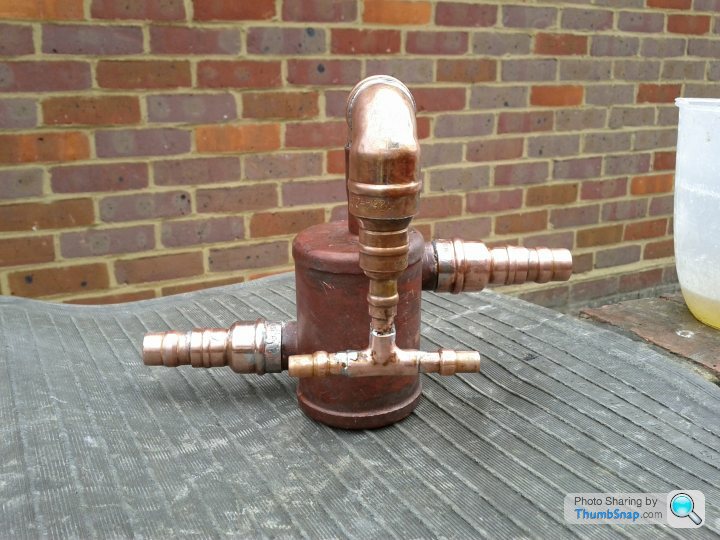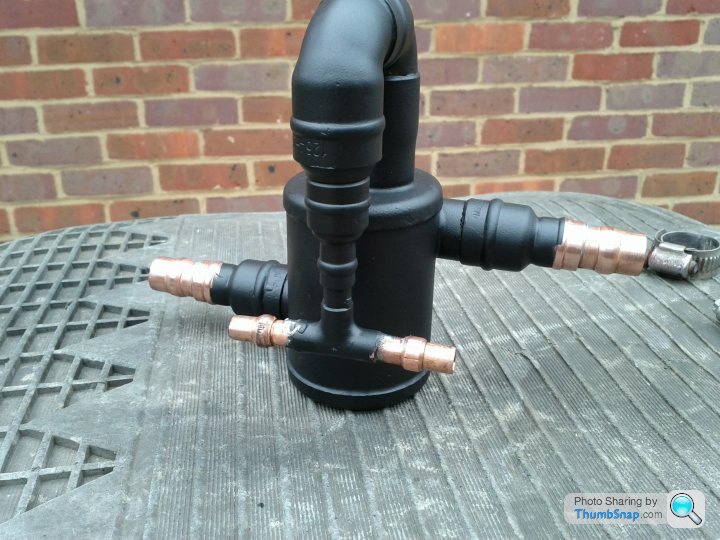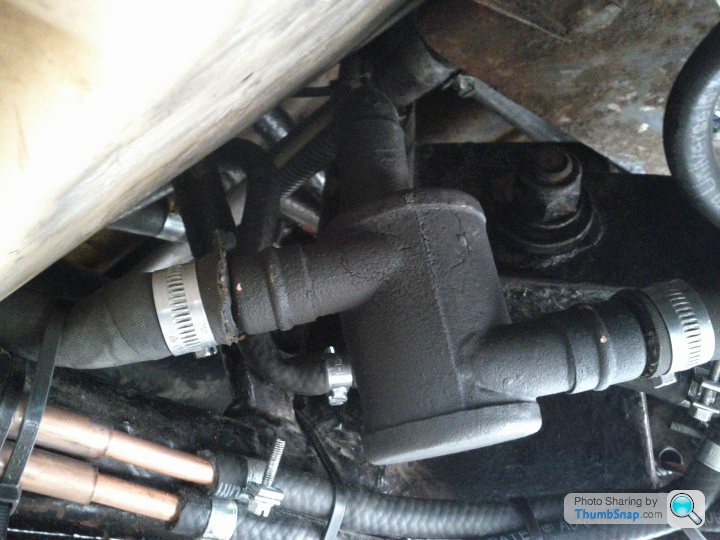Anti-surge Tank - DIY
Discussion
If you can solder together some basic plumbing connections you can knock up this DIY ant-surge tank for less than £20.



The last picture is slightly skewed. On the car the tank tilts slightly towards the back of the fuel pump. The smaller pipes connect into the fuel return line. It holds 150cc of petrol which should be enough for bends and roundabouts on the road but maybe not enough for track use.
Only one test drive so far and it seems to work.



The last picture is slightly skewed. On the car the tank tilts slightly towards the back of the fuel pump. The smaller pipes connect into the fuel return line. It holds 150cc of petrol which should be enough for bends and roundabouts on the road but maybe not enough for track use.
Only one test drive so far and it seems to work.
The fuel should also "swirl" due to the in and outs being staggered...
Oh and I found this in case anyone asks...
This is in response to copper inquiry.
There are some molecules that may be present in gasoline which would react with copper. This reaction process is referred to as corrosion. Refiners control/remove these molecules in the gasoline production process to protect copper components in fuel systems. All Shell gasoline is certified to meet the ASTM D130 Standard Test for Corrosiveness to Copper in order to provide assurance.


Oh and I found this in case anyone asks...
This is in response to copper inquiry.
There are some molecules that may be present in gasoline which would react with copper. This reaction process is referred to as corrosion. Refiners control/remove these molecules in the gasoline production process to protect copper components in fuel systems. All Shell gasoline is certified to meet the ASTM D130 Standard Test for Corrosiveness to Copper in order to provide assurance.

Looks quite a bit cheaper that the TVR car parts item:
https://tvr-parts.com/tvr-parts/part-details/tvr-0...
or the ACT item
http://www.actproducts.co.uk/product/ssp09-tvr-wed...
https://tvr-parts.com/tvr-parts/part-details/tvr-0...
or the ACT item
http://www.actproducts.co.uk/product/ssp09-tvr-wed...
Looks interesting - what is the body made from?
You could save even more money by using end-feed instead of solder ring... (I always add a bit of solder anyway)
As for the copper problem how about tinning the inside of all the components before assembly, then there will be a thin coating of lead (if you use the good stuff) and tin, instead of pure copper in contact with the fuel.
You could save even more money by using end-feed instead of solder ring... (I always add a bit of solder anyway)
As for the copper problem how about tinning the inside of all the components before assembly, then there will be a thin coating of lead (if you use the good stuff) and tin, instead of pure copper in contact with the fuel.
Ahh the copper problem - well apart from the fuel posted up by Zig above, petrol is supposed to dissolve copper (only very slightly mind) and then the copper gets deposited around, probably the only place in the wedge engine this might happen is at the injector outlets, or onto the inlet valves. Only the former might be affected although I expect hardly much at all especially with only the swirl pot contributing.
It may be more of a problem if you're on carbs.
It may be more of a problem if you're on carbs.
adam quantrill said:
It may be more of a problem if you're on carbs.
I thought some carb jets were copper...and brass.....Initially copper and fuels were not a problem...Boats have had copper tanks in the past...The issue may be in the additives that are in modern fuels, and also the ppm of such additives have significantly increased since they were introduced....Why cant we just brew our own ethanol... FFS!!
FFS!!Edited by mrzigazaga on Saturday 29th April 22:12
Silver solder only.
Soft soldered joints aren't permissible in fuel lines as the solder is slowly dissolved in petrol and it doesn't take much heat in the event of a fire for them to let go completely.
This said, the connections to the tanks in my wedge are soft soldered and have lasted for 30 years. I think it would be a very long time before your Yorkshire fittings fail.
Soft soldered joints aren't permissible in fuel lines as the solder is slowly dissolved in petrol and it doesn't take much heat in the event of a fire for them to let go completely.
This said, the connections to the tanks in my wedge are soft soldered and have lasted for 30 years. I think it would be a very long time before your Yorkshire fittings fail.
Gassing Station | Wedges | Top of Page | What's New | My Stuff




